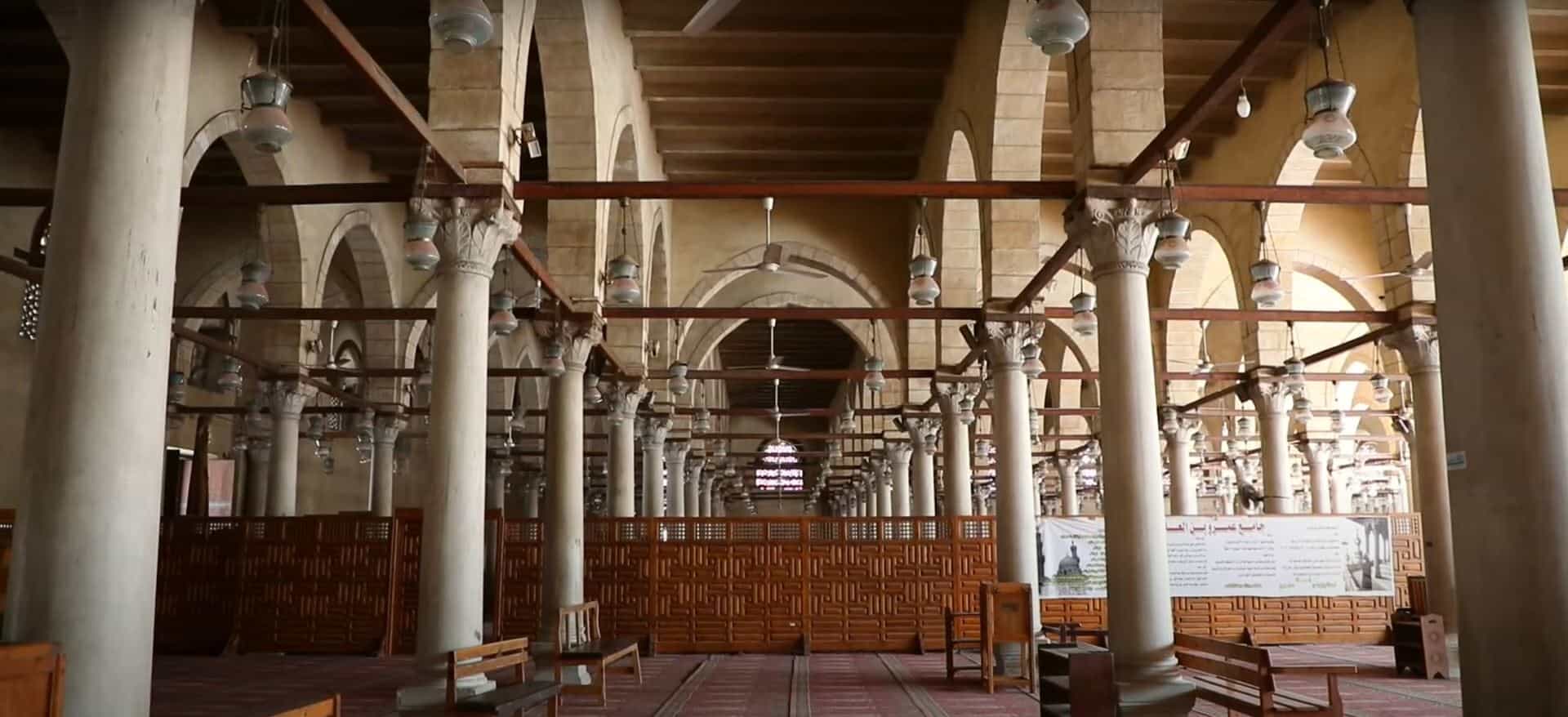Mosque of Amr ibn al-As – Egypt

Updated On: February 27, 2024 by Ahmed Samir
Egypt is a land steeped in history, with a rich and diverse cultural heritage that spans thousands of years. Among its many treasures, the Mosque of Amr ibn al-As stands as a testament to the early Islamic presence in Egypt. Located in the heart of Cairo, this historic mosque holds a special place in the hearts of Muslims and historians alike. This article will explore the fascinating history and architectural significance of the Mosque of Amr ibn al-As, shedding light on its enduring legacy.
The Rich History of the Mosque of Amr ibn al-As
To understand the importance of the Mosque of Amr ibn al-As, we must delve into the historical context of its construction. The mosque was built in 642 CE by Amr ibn al-As, a prominent figure in early Islamic history. Amr ibn al-As was a companion of the Prophet Muhammad and played a pivotal role in the Islamic conquest of Egypt.
The conquest of Egypt was a significant event in the expansion of the Islamic empire. It marked the beginning of the spread of Islam into North Africa and the establishment of Islamic rule in one of the world’s most culturally and historically rich regions. As the commander of the Muslim forces, Amr ibn al-As played a crucial role in this conquest.
Construction of the Mosque
After the conquest of Egypt, Amr ibn al-As built a mosque in the newly conquered land. The Mosque of Amr ibn al-As began in 642 CE, making it one of the earliest mosques ever built in Egypt and one of the oldest in the world. The mosque was constructed on the site of a tent that had served as a place of worship during the Muslim military campaign.
The architecture of the mosque was simple, reflecting the early Islamic style. It consisted of mud-brick walls, wooden columns, and palm tree trunks for support. The roof was made of palm fronds and leaves, creating a humble yet functional structure. The mosque was designed to accommodate the growing Muslim community in Egypt and served as a centre for religious and social activities.
Significance and Legacy
The Mosque of Amr ibn al-As holds immense significance in Islamic history for several reasons:
- Historical Significance: As one of the earliest mosques in Egypt, the Mosque of Amr ibn al-As represents the establishment of Islam in the region. It symbolises the early Islamic presence in Egypt and the spread of the religion beyond the Arabian Peninsula.
- Community Centre: Beyond its role as a place of worship, the mosque served as a community centre where Muslims gathered not only for prayers but also for social, educational, and administrative purposes. It played a pivotal role in shaping the social fabric of early Islamic Egypt.
- Architectural Influence: The mosque’s simple yet functional architecture influenced the design of subsequent mosques in Egypt and the broader Islamic world. Its use of local materials and construction techniques set a precedent for Islamic architecture in the region.
- Preservation of History: The mosque has undergone several renovations and restorations over the centuries, with each effort to preserve its historical and cultural significance. These efforts have ensured that the mosque remains a living testament to Egypt’s Islamic heritage.
The mosque’s enduring legacy can be seen in its continued use as a place of worship and its importance to the local Muslim community. It also attracts tourists and scholars worldwide, eager to explore its historical and architectural significance.
Architectural Features
While the original mosque was a simple mud-brick structure, it has undergone numerous renovations and expansions over the centuries. These renovations were necessary to maintain the mosque’s structural integrity and accommodate the growing Muslim population in Cairo. As a result, the current Mosque of Amr ibn al-As displays a blend of architectural styles from different periods.
- Main Prayer Hall: The central prayer hall of the mosque is the most critical area. It is characterized by rows of columns and arches that support the roof. The columns are made of various materials, including stone, marble, and granite, reflecting the different historical construction periods.
- Mihrab: The mihrab is a niche in the wall that indicates the direction of Mecca, towards which Muslims pray. It is an essential feature in any mosque and is typically elaborately decorated. The mihrab in the Mosque of Amr ibn al-As features intricate geometric designs and Quranic inscriptions.
- Minaret: The mosque’s minaret is another significant architectural element. The current minaret differs from the original one but was added during the Fatimid period in the 10th century. It is an impressive structure with intricate details and is a prominent landmark in Cairo.
- Courtyard: The mosque’s courtyard, or sahn, is a spacious area surrounded by porticos with columns. It provides a serene space for worshippers to gather and offers relief from the bustling streets of Cairo. The courtyard is also adorned with decorative elements, including fountains and plantings.
- Decorative Details: Throughout the mosque, decorative elements such as calligraphy, geometric patterns, and floral motifs. These intricate designs add to the beauty and spiritual atmosphere of the mosque.
Renovations and Restorations
Over the centuries, the Mosque of Amr ibn al-As has undergone several renovations and restorations to preserve its historical and architectural significance. These efforts have aimed to maintain the structural integrity of the mosque while safeguarding its heritage.
One of the most significant renovations occurred during the Fatimid period in the 10th century. This renovation added the minaret above and made other architectural enhancements to the mosque. Subsequent renovations were carried out during the Mamluk and Ottoman periods, each leaving its mark on the mosque’s architecture.
The Egyptian government has taken steps to preserve and protect the mosque in the modern era. Conservation efforts have included repairs to the mosque’s walls, roof, and decorative elements. These initiatives have ensured that the Mosque of Amr ibn al-As stands as a symbol of Egypt’s rich Islamic history.
Cultural and Religious Significance
The Mosque of Amr ibn al-As is a historical and architectural gem of great cultural and religious significance. It has played a vital role in the lives of the Muslim community in Egypt for over a millennium. Here are some aspects of its cultural and religious significance:
- Religious Practice: The mosque continues to be a place of worship for Muslims in Cairo. It holds daily prayers, Friday congregational prayers, and special religious events. The mosque’s importance in the community’s religious life cannot be overstated.
- Historical Pilgrimage: For devout Muslims, visiting the Mosque of Amr ibn al-As is a religious pilgrimage. It allows them to connect with the early history of Islam and pay homage to the companions of the Prophet Muhammad, who contributed to the spread of the faith.
- Cultural Heritage: The mosque is integral to Egypt’s cultural heritage. It represents the fusion of Islamic and Egyptian cultures and serves as a reminder of the country’s long history of religious tolerance and coexistence.
- Educational Center: Historically, mosques have served as centres of learning and education. The Mosque of Amr ibn al-As has played a role in disseminating Islamic knowledge and scholarship over the centuries.
Visiting the Mosque
The Mosque of Amr ibn al-As is open to visitors, both Muslims and non-Muslims, who wish to explore its historical and architectural significance. When visiting the mosque, respecting its religious and cultural importance is essential. Here are some tips for visitors:
- Modest Dress Code: Visitors should dress modestly, covering their arms and legs, and women should wear a headscarf. This attire is a sign of respect for the mosque and its worshippers.
- Remove Shoes: Before entering the prayer hall, visitors are expected to remove their shoes. This is a common practice in Islamic places of worship.
- Quiet and Respectful Behavior: Visitors should maintain a respectful and calm demeanour inside the mosque. It is a place of worship, and loud talking or disruptive behaviour is discouraged.
- Photography: While photography is generally allowed in the mosque, it is essential to be respectful and avoid taking pictures of worshippers without their consent.
- Check Opening Hours: It is advisable to check the mosque’s opening hours before planning a visit, as they may vary during different times of the day and year.
Last Words
The Mosque of Amr ibn al-As is a living testament to the early history of Islam in Egypt and the region’s enduring cultural and religious significance. As one of the oldest mosques in Egypt and the world, it stands as a symbol of the spread of Islam beyond the Arabian Peninsula and the enduring legacy of the Prophet Muhammad’s companions.
Through centuries of renovations and restorations, the mosque has retained its architectural beauty and historical importance. It continues to serve as a place of worship, a cultural heritage centre, and a destination for visitors eager to explore Egypt’s rich history.
As a timeless symbol of Egypt’s Islamic heritage, the Mosque of Amr ibn al-As invites us to reflect on the profound impact of Islam on the cultural, religious, and architectural landscape. Its enduring legacy is a source of inspiration and connection to the past for generations.






